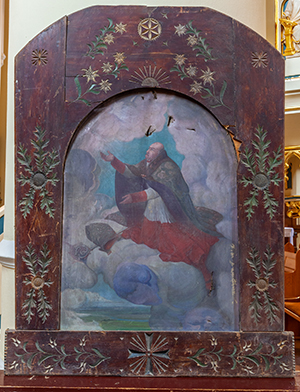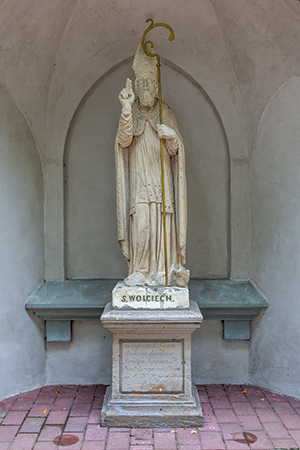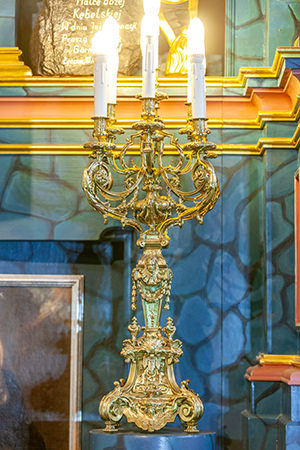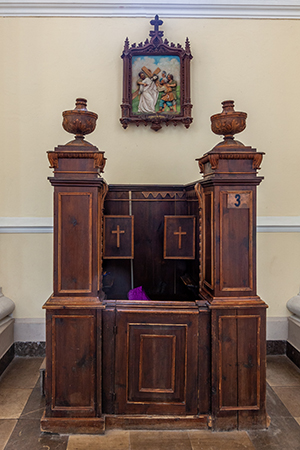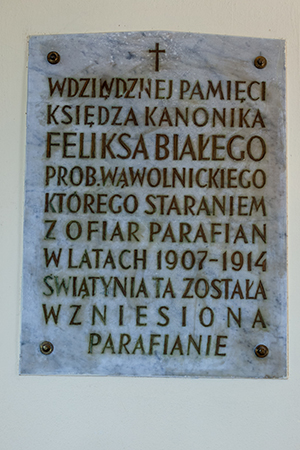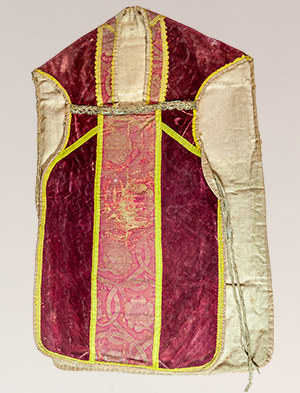Monuments
The frame of St Clement's painting is located in the Church, the main altar is centrally visible from the entrance, and on its left side, in the left side nave of the church there is a side altar. Next to the altar is the Frame of the painting of St. Clement. In 2001, Pope John Paul II consecrated the church to the Minor Basilica.
The side altar is in the transept, the transept is the transverse nave of the church, the nave perpendicular to the axis of the church, located between the chancel and the rest of the building.
The style of the painting's frame is the folklore-Zakopian style, which appeared at the turn of the 19th and 20th centuries. The frame is made of wood. The material is pine, the frame is carved and painted with clear varnish.
The dimensions of the frame of St Clement's painting is 164 centimetres (height) by 122 centimetres (width).
The statue of St. Adalbert is located outside the church, centrally standing in front of the entrance to the church, one should be directed to the left. The statue is located in a niche in the southern elevation of the Church. In 2001, Pope John Paul II consecrated the church to the Minor Basilica.
The statue is made of sandstone depicting the figure of St. Wojciech, the saint patron of the Minor Basilica. St. Adalbert was a Czech Catholic clergyman, Bishop of Prague, Benedictine, missionary, martyr. He is a saint of the Catholic Church, apostle of Prussia and saint patron of Poland.
According to tradition, St. Adalbert was to be the author of the song Bogurodzica, which although not confirmed by source materials, in the opinion of Józef Birkenmajer published in the monograph about the work (1937) can be associated with a probable inspiration for the work coming from the group of missionaries, confreres of St. Adalbert from the Benedictine Order, who came with him to Poland. The style of the statue is eclecticism.
A pair of candelabras is located in the chapel of the Holy Mother of Kębło. The candelabras are eight-candles and they are placed on both sides of the main altar in the Chapel. Kandelabry są ośmio-świecowe i są umieszczone po obu stronach ołtarza głównego w Kaplicy.
The candelabra is a large, standing, several-armed candlestick. Candelabras or candlesticks were made mainly of metal and were known in ancient times. At the end of the 17th century, two-armed candelabras were popular, three-armed in the 18th century, and in the 19th century, several-armed candelabras were also made. The candlestick was built of a base, a shaft and, most often, a removable retable with arms.
The style of the candelabra is neo-Baroque. Material and technique - bronze. Candelabras were painted in gold. The base has 4 legs, passing into the shaft, decorated with numerous ornaments and a retable with 8 arms on which there are candles. The candelabras form part of the main altar of the Holy Mother of Kębło.
A pair of confessionals located in the Church in the left and right nave. The confessionals are placed symmetrically opposite each other, facing frontally the central axis of the church. In 2001, Pope John Paul II brought the church to the dignity of the Minor Basilica. The altar is free-standing, behind the altar in the background there is a chancel.
Confessionals were made at the turn of the nineteenth and twentieth century, they are made in the Neoclassical style. The height of the confessionals is 240 cm. They are made of wood, a massive pine type. The confessionals are located in a small side transept, located at the back part of the Minor Basilica.
Above each of the confessionals there is a painting depicting the Way of the Cross station. The confessionals are in good condition and they are painted with clear varnish.
The memorial is located in the Church. In 2001, Pope John Paul II consecrated the Church to the dignity of the Minor Basilica. The memorial is located at the entrance to the church in the left side nave.
The text on the plaque "In remembrance of the Grateful Memory of Canon Feliks Biały parish priest of Wąwolnica who, thanks to the collections of parishioners in the years 1907-1914, built the temple. The parishioners."
The memorial is made of white marble, with letters carved in marble painted in gold. In the upper part, above the inscription, there is a small cross. The memorial was funded thanks to the collections of parishioners in 1914. The size of the memorial is 81 centimetres high and 50 centimetres wide.
Read more: THE MEMORIAL OF PRIEST FELIKS BIAŁY AND THE MEMORIAL OF BUILDING A CHURCH
The chasuble is in the museum under the chapel. Chasuble (latin “ornare” - to decorate; “ornatus” - decorative clothing, adorned, magnificent, ornament) — in Roman Catholic, Old Catholic, Lutheran and Anglican liturgy a vestment worn by a priest during the Mass and all actions directly connected to the Mass.
Front and back: burgundy silk background with embellishments featuring thick vine, large flowers and fern leaves. The pattern is embroidered with gold thread and in some places with burgundy silk thread. The vines intertwine with each other creating onion shaped gaps filled with flowers with stems. Vines, flowers and leaves’ edges are detailed with burgundy silk. Sides of burgundy velvet have been added at a later time. Burgundy silk fabric with damask pattern (Italian: brocatello). The style of the chasuble is renaissance.
The chasuble is dated for the turn of 16th and 17th century. Length: 116 cm
Subcategories
Page 6 of 14









